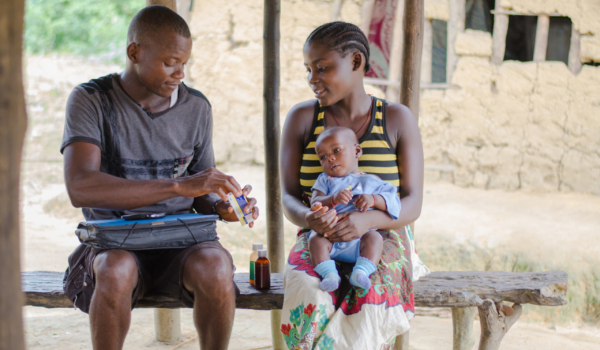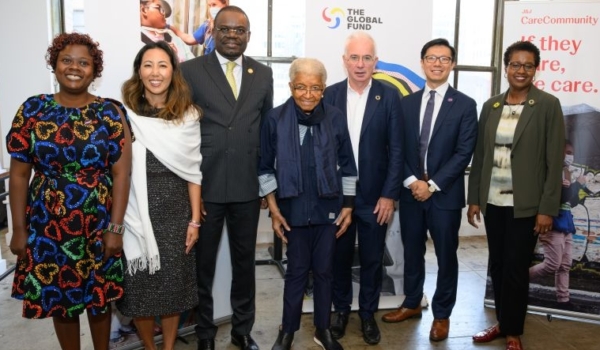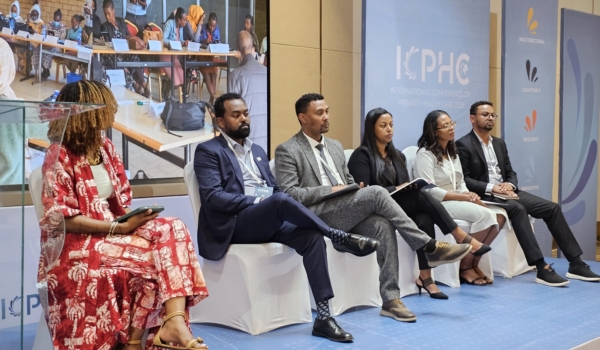This blog post was co-written by Katey Linskey of Last Mile Health and Crystal Lander and Taylor Capizola of Living Goods.
The 71st World Health Assembly (WHA) was Dr. Tedros Ghebreyesus’ first as the Director General of the World Health Organization. As expected, expectations were high, and the conversation around the World Health Organization’s (WHO) main theme—Universal Health Coverage (UHC)—was serious and solution-driven. Though there were meaningful discussions on achieving, financing, and optimizing UHC, questions on how to effectively finance UHC lingered. The discussion of financing UHC is a difficult one—it requires diverse thinking, nuanced planning, and blended visions. In an attempt to tackle this, the Center for Global Health and Diplomacy, Johnson and Johnson, Last Mile Health, and Living Goods joined forces to bring a group of amazing leaders who are tackling the difficult discussion around getting to UHC with a particular focus on community health.
The event opened with remarks from the Honorable Wilhelmina Jallah, the Liberian Minister of Health, who acknowledged the importance of national community health worker systems, a sentiment echoed by others including the Honorable Minister of Rwanda Dr. Diane Gashumba and Honorable Minister Dr. Jane Ruth Aceng of Uganda. In Liberia, the National Community Health Assistant Program has now scaled to over 70 percent of the country. Minister Jallah made it clear that this progress was made possible by partnerships, including hard work from the Ministry of Health; donor alignment among the US Agency for International Development (USAID), UNICEF, and the World Bank; and concentrated technical assistance by nongovernmental organizations, such as Last Mile Health, the Clinton Health Access Initiative, and the International Rescue Committee. Building off strong partnership with governments across the continent, Dr. Angela Gichaga, CEO of the Financing Alliance for Health, highlighted her organization’s success in supporting countries to build costed investment plans for their national community health workers programs. Dr. Gichaga also stressed that using this costing method to build financial roadmaps could lead to increased investment and aligned funding to the programs.
Innovative programs like the Financing Alliance for Health do not operate in a silo, but rather leverage the major donors in the space. As Deputy Assistant Administrator for USAID Bureau of Global Health Dr. Alma Crumm-Golden noted, USAID has worked with community health workers (CHWs) for 45 years and the agency remains committed to supporting governments in growing national community health programs. As a paediatrician, Dr. Crumm-Golden has seen the difference CHWs can make in ensuring access to Integrated Community Case Management services, a strategy utilizing community health workers to identify and treat common childhood illnesses, and extending primary healthcare services to children in remote “last mile” areas.
We know the national community health plans will not work without a financing plan. Mariam Claeson of the Global Financing Facility at the World Bank shared how they are supporting countries in developing investment cases that prioritize reproductive, maternal, child, and adolescent health services. These investment cases help the private sector support the government plans by providing clear investment priorities that are aligned to national strategies. Joanne Manrique, President of the Center for Global Health and Diplomacy (GHD) who has been leading the efforts to work with investment firms over the past six years to address health and development challenges across the globe introduced Mr. Gerhard Pries, CEO and Managing Partner, Sarona Asset Management who spoke about the role blended financing can play in developing sustainable interventions. In addition, he addressed the lingering misconceptions and prejudices between the different sectors. He also spoke of the eagerness of the private equity firms to work with governments in providing financing solutions to address global health challenges. The evening closed with Dr. John Nkengasong of the African Centers for Disease and Control (CDC), who had just returned from the DRC where he was working on containing the current Ebola outbreak. He acknowledged the various CHW programs across the continent that have not only been utilized to respond to crises like Ebola in West and Central Africa but also in providing day-to-day primary healthcare services that build and strengthen resilient health systems at the community level.
If we are to truly “make the last mile the first mile”, the global community needs to leverage the momentum from events like these at the World Health Assembly and drive true partnership for change. We recommend the following:
- Governments must be empowered and supported by donors and NGO partners with donor funding cycles aligned to national strategies and timelines and tailored technical assistance to develop, implement, and manage national community health programs.
- National community health programs must have cost investment cases and financing roadmaps to ensure sustainability.
- The private sector and major donors must have access to data to strengthen government relationships necessary to prioritize community health programs.
The Center for Global Health and Diplomacy, Johnson and Johnson, Last Mile Health, and Living Goods extend their thanks to all the speakers and attendees of “The Role of Blended Financing in Providing Sustainable Solutions for Community Health Programs” and look forward to moving from conversation to action in order to ensure that every community has access to the quality care they deserve.




